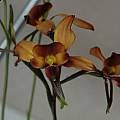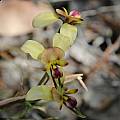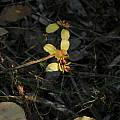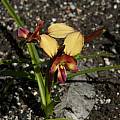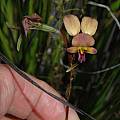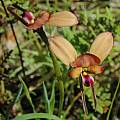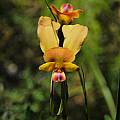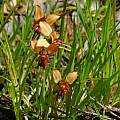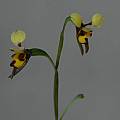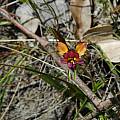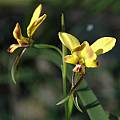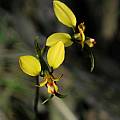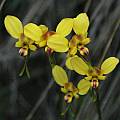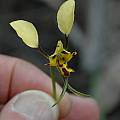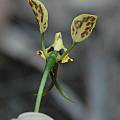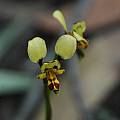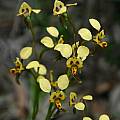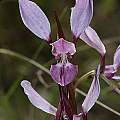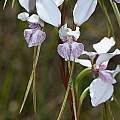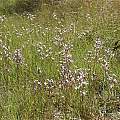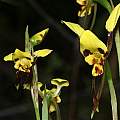Diuris is a genus of tuberous terrestrial plants in the Orchidaceae family. There are more than fifty described species native to Australia and one species endemic to Timor. The name means double tailed which refers to the lateral sepals that extend under the lip and are often crossed. This genus also had two prominent petals that protrude from the top of the flower like a donkey’s ears giving many of the species a common name of Donkey Orchids. Flowers are usually yellow or purple and often blotched or spotted with brown.
Diuris amplissima is a species named in 1991 that is native to southwestern Western Australia where it grows in sand in moist areas adjacent to creeks or swamps. Flowers are combinations of yellow, brown, and purple. Height range: 40-50 cm. Photo taken by Bob Rutemoeller at a wildflower show in Western Australia September 2007.
Diuris corymbosa , syn. Diuris longifolia var. corymbosa, is a common species that grows in sand, granite and gravel in open forests, woodlands, and shrubland in winter wet areas of Western Australia. It has yellow flowers with reddish-brown markings and suffusions. This species is known as the Donkey orchid and is smaller than Diuris orientis from eastern Australia. It has been confused with Diuris longifolia but that species is less yellow and has a lip with side lobes that are larger than the folded central lobe. Height range: 20-40 cm. Photos taken by Bob Rutemoeller and Mary Sue Ittner of what we think is this species seen near Albany, Western Australia September 2007.
I’m not really sure of the identity of these species seen at Porongurup National Park and William Bay National Park, Western Australia. Malcolm Thomas, an Australian who grows a lot of the native orchids suggests considering them Diuris sp aff. corymbosa as this species has so many forms that identification is a challenge. Photos by Mary Sue Ittner and Bob Rutemoeller taken September 2007.
Diuris laxiflora is native to Western Australia where it grows in sand, lateritic loam or clay in winter wet swamps, on the margins of granite rock outcrops, in coastal heath, and woodland. It is known as the Bee Orchid. Flowers are bright yellow with brown on the extremities. The lip has a broad protruding central folded lobe and two shorter spreading side lobes. Height range: 31-70 cm. Photo taken by Bob Rutemoeller at a wildflower show in Western Australia September 2007.
Diuris longifolia grows in variable soil types and is found in moist situations, jarrah and karri forests and granite outcrops in southwestern Western Australia. It is known as the purple pansy orchid. Flowers are mauve to light purple with pale yellow suffusions. Height range: 10-35 cm. Photos by Mary Sue Ittner of plants that could be this species taken near Albany and the Kalgan River and in Porongurup National Park, Western Australia September 2007. The first one also could be a variation of Diuris corymbosa.
Diuris orientis is native to New South Wales, Victoria, Tasmania, and South Australia where it grows in forest, woodland, heathland and grassland. Flowers are yellow with reddish-brown suffusions in a wallflower pattern. It has a lip with the spreading side lobes a similar length to the projecting central lobe. Height range: 10-40 cm. Photos by Bob Rutemoeller and Mary Sue Ittner taken on the Great Ocean Walk near Apollo Bay in Victoria October 2007.
Diuris pardina is found in open forest, woodland, and heath in a number of states in southern Australia. Known as the leopard orchid, flowers are yellow, but heavily blotched red-brown. Flowers can be found in colonies. Height range: 14-40 cm. Photographs taken by Bob Rutemoeller and Mary Sue Ittner in the Grampians, Victoria, October 2007.
Diuris punctata , syn. Diuris elongata, is a widespread and sometimes locally common species of moist grassland. It is known as the purple Donkey Orchid. It is found in the Australian states of New South Wales, Queensland, Victoria, and South Australia. Flower stems are from 20 to 60 cm and the flower color varies white to mauve to purple and rarely yellow. This species grows well in cultivation. Photos taken by Andrew Harvie in Yengo National Park, New South Wales, showing variations in color in the same population.
Diuris sulphurea , syn. Diuris latifolia, is a wide spread species found in scattered colonies in open forest in Queensland, New South Wales, Victoria, Tasmania, and South Australia. Known as the Tiger Orchid, it has bright sulphur yellow flowers with dark brown blotches. It is characterized by a single ridge on the labellum and two brown blotches on the dorsal sepal. It varies in size from 25 to 75 cm. tall. Photo from Andrew Harvie of a smaller plant taken in Yengo National Park, New South Wales.
